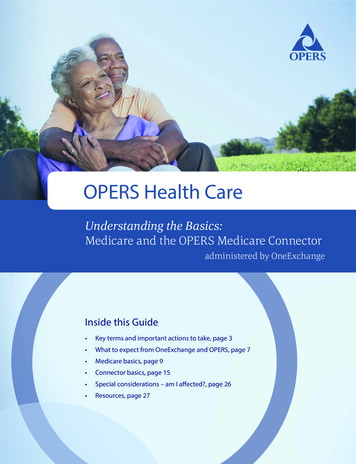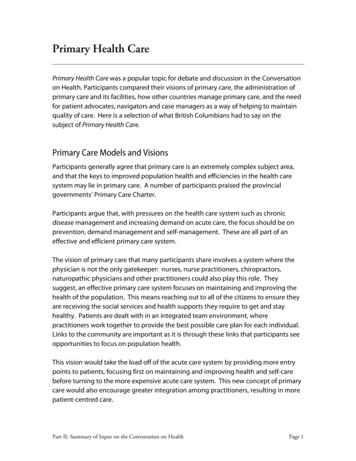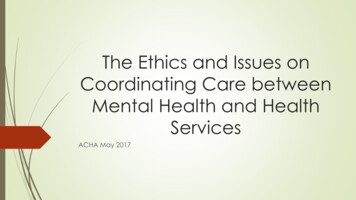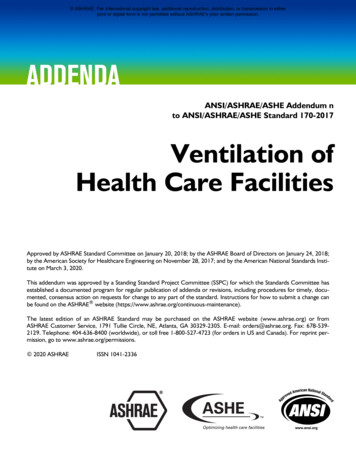
Transcription
OPERS Health CareUnderstanding the Basics:Medicare and the OPERS Medicare Connectoradministered by OneExchangeInside this Guide Key terms and important actions to take, page 3 What to expect from OneExchange and OPERS, page 7 Medicare basics, page 9 Connector basics, page 15 Special considerations – am I affected?, page 26 Resources, page 27
Key terms you need to know andimportant actions to takeInside this guide, participants will findhelpful information about Medicare and theOPERS Medicare Connector, administerd byOneExchange. The guide reviews important stepsto take for enrolling in Medicare and a medical/prescription plan supplement, it also addressesdifferences between Medigap and MedicareAdvantage plans, provides detailed informationabout the reimbursement process, and muchmore. Below are some key words you need toknow as well as important steps to take withOPERS and OneExchange.Key termsHealth Reimbursement Arrangement(HRA) – An account funded by OPERS thatprovides tax-free reimbursement for qualifiedmedical expenses such as monthly insurancepremiums, Medicare Part B premiums andcopays incurred by eligible participants.OneExchange will administer the HRA, andwill provide education to the participant onhow to use the account and complete thereimbursement process. Refer to QualifiedMedical Expenses definition for examples.HRA Allowance – Eligible participants willreceive a monthly amount deposited into anHRA upon enrolling in a medical plan throughOneExchange. The amount of the allowance isdependent on years of service credit and age atretirement.Licensed Benefit Advisor – An employee whoworks for OneExchange and provides supportto participants in selecting individual Medicareplans, resolving claims issues and changingMedicare plans, if necessary. Licensed BenefitAdvisors are licensed by state departments ofinsurance and must be certified by the healthinsurance carriers before they can enroll retireesinto their products.Medicare Advantage plans – An insurance planprovided by a private insurance carrier thatcombines coverage for hospital costs, doctorvisits and other medical services. Prescriptiondrug coverage is typically included. These planshave lower premiums, but higher costs whenindividuals access health care. Individuals mustbe enrolled in Medicare Parts A and B to beeligible for a Medicare Advantage plan.Medical Underwriting – A process throughwhich a Medigap (Medicare Supplement)insurance carrier can ask a retiree about his/herhealth status — if the participant failed to enrollin a Medicare plan during the enrollment periodor within the time frame for special enrollmentperiod (e.g. leaving group coverage or aging intoMedicare). Medical underwriting may resultin denied coverage or a higher premium dueto health status. Participants do not need to beconcerned about medical underwriting duringenrollment as long as enrollment occurs duringthe initial enrollment period.Medigap (Medicare Supplement) plan – Aprivate health insurance that supplements orfills in the “gaps” where Medicare Parts A and Bleave an individual uncovered. Medigap plansdo not have networks. They typically have highermonthly premiums, but little to no out-of-pocketcosts. A separate Part D drug plan needs to beselected for prescription coverage.3
Key terms you need to know andimportant actions to takeKey terms (continued)OneExchange – The company OPERS haschosen to administer the OPERS MedicareConnector and HRA. OneExchange is the longestand oldest Medicare Connector in the countryand is a division of Willis Towers Watson, a100-year-old benefits consulting firm.Medicare Connector – A service offered toOPERS participants enrolled in Medicare PartsA and B that provides individual plan selectionassistance. The Connector is administered byOneExchange for OPERS and their Medicareeligible retirees and dependents. This modeloffers more affordable choices to Medicareretirees than a group Medicare plan.Understanding the Basics4Original Medicare – Consists of the two originalparts of Medicare: Part A (hospital insurance)and Part B (outpatient medical insurance).Qualified Medical Expenses – These areexpenses generated by the participants thatcan be submitted for reimbursement from aretiree’s HRA; including medical, prescription,dental and vision premiums, Medicare Part Bpremiums, and doctor and prescription copays.The IRS defines qualifying expenses.
Key terms you need to know andimportant actions to take“To-do” Checklist: OPERS and OneExchangeOPERSOneExchangeEnroll in Medicare Parts A and B(Original Medicare) through SocialSecurity. Remember, this will be aparticipant’s primary insurance sinceMedicare provides about 80 percentcoverage.Prepare for making medical andpharmacy plan selections by readingthe information OneExchange willmail to participants including anenrollment guide.Provide proof of Medicare Parts Aand B enrollment to OPERS. FollowMedicare enrollment guidelines asoutlined in this guide. For additionalinformation about signing up forMedicare, contact your local SocialSecurity office, visit ssa.gov or call1-800-772-1213.3For more information on theMedicare Connector administered byOneExchange, visit opers.org.Schedule the enrollment call bycalling 1-844-287-9945. This willallow participants to enroll in anindividual Medicare plan thatsupplements Medicare Parts A and B.Setup an online personal profilethrough OneExchange atmedicare.oneexchange.com/opers byentering essential information, or fillout the personal information in theenrollment guide in advance of theenrollment call.Three items to do:1Enroll in Medicare.2Provide required proof of Medicareenrollment to OPERS.3Call OneExchange to set up an enrollmentcall to enroll in supplemental plans.5
Introduction: What to Expect fromOneExchange and OPERSOPERS has partnered with OneExchange to helpretirees and eligible dependents find and enrollin an individual Medicare plan. Remember,Original Medicare (Parts A and B) providesthe majority of health care coverage. The planselected through OneExchange supplementsOriginal Medicare. Through OneExchange,participants will be able to choose a plan froma large number of insurance carriers to ensurethe right coverage is selected that best fits themedical, budgetary and lifestyle needs of theretiree and their eligible dependents.It is important that Medicare-eligible retireesunderstand what to expect and how to preparein the months leading up to selecting a plan.Ready. Set. Prepare.Ready. Set. Enroll.Create a OneExchange online personalprofile atmedicare.oneexchange.com/opers.Make the required enrollment call toOneExchange.Schedule the required enrollment call withOneExchange by calling toll-free,1-844-287-9945.Research plan options throughOneExchange online atmedicare.oneexchange.com/opers.Prior to the enrollment call, OneExchangewill mail an enrollment guide that featuresinformation dedicated to the enrollmentprocess.In the days leading up to the enrollmentcall, review some of the questions that willbe asked as described in the enrollmentguide – think about physician and healthcare provider names, prescription drugs, thenumber of planned visits and proceduresin the next year. For more informationabout the enrollment process and to viewinstructional videos, visitmedicare.oneexchange.com/opers.Make the premium payment to theinsurance carrier selected – premiumpayment schedules vary by carrier. Theinitial monthly payment could be due asearly as seven to 10 days after the initialenrollment has been processed.After the enrollment call, participants willreceive a selection confirmation letter fromOneExchange that includes a confirmationnumber, name of selected insurance carrierand plan selections, premium amount, andcoverage effective date.Following the processing of the application,the new plan carrier will mail a planacceptance letter that confirms enrollmentinto the selected plan and details any otherimportant information.Approximately 10 days after the enrollmentcall, OneExchange will mail a GettingReimbursed Guide that details the HRA andhow to access and manage funds throughoutthe year.PL EASE RE ME MBE RTo schedule an appointment, create an online personal account, researchplans and review your Enrollment Guide prior to your enrollment call withOneExchange.7
What to expect from OPERS andOneExchangeOther Key ConsiderationsPlan participants must be enrolled in MedicareParts A and B to enroll in a plan throughOneExchange. Additionally, Medicare PartsA and B coverage must be in place as of theparticipants plan effective date and can beapplied for up to three months prior to thedesired effective date. For more informationabout enrolling in Medicare Parts A or B, contactthe local Social Security office, visit ssa.gov or call1-800-772-1213. Social Security Administrationonly allows enrollment during specific times ofthe year. More information about these times canbe found on page 9 in this guide.Participants must be enrolled in Medicare Parts A and B, enroll in a plan throughOneExchange and cannot be re-employed in an OPERS-covered position to receive anHRA allowance. (Refer to page 25 for options for re-employed retirees.)Participants can learn the amount of their allowance in the following ways:Understanding the Basics81.Run an estimate using the health care estimator tool using your online account.2.Refer to the personalized OPERS packet of information, sent in the monthsleading up to turning age 65.
Medicare BasicsMedicare is federal health insurance for those 65and older, under age 65 with certain disabilitiesand any age with End-Stage Renal Disease(permanent kidney failure requiring dialysis or akidney transplant).CoverageincludesCoveragedoes notincludeEligibilityneedsMedicare costs vary depending on plan, coverageand the services used. Here are four parts thatmake up the Medicare program:HOSPITALSOUTPATIENT SERVICESMedicare Part AMedicare Part B Inpatient care in hospitals and some skilled nursingfacilities Some health and hospice care Long-term nursing home stays Non-medical, in-home care 40 quarters of Medicare social security credit, meaningyou and your employer paid for Medicare Part A throughpayroll deductions, or you worked for a job covered bySocial Security.- OR - Doctor’s services (physicians and specialists) Some lab work, x-rays, therapy and durable medicalequipment Vision Dental Nonprescription drugs and supplies You are eligible to enroll at the age of 65. Qualifying illness or disability. Through a spouse’s work record, if you do not haveenough quarters to receive Medicare Part A at no cost.FactCoverageMost public employees pay into Medicare even thoughthey don’t pay into Social Security.PRIVATE INSURANCE THAT REPLACESTRADITIONAL MEDICARE PARTS A AND B, ANDPROVIDES HIGHER COVERAGEPRESCRIPTIONSMedicare Advantage (Part C)Medicare Part D- Sometimes Covers -- Covers - Vision & Dental Prescription drugs including generic, brand name andspecialty drugs at participating retail pharmacies and homedelivery. Usually combined with a drug plan (MAPD)PrivateCompanyPlansThere is a monthly premium based on income. HMO: Health Maintenance Organizations PFFS: Private Fee-for-Service N/A PPO: Preferred Provider OrganizationsPremiums Monthly premiums vary depending on your state,private insurer and if you choose an HMO or PPO foryour Medicare Advantage coverage. You will pay a monthly premium. Part D coverage is paideach month.Fact Medicare Advantage plans have provider networks. Prescription drug coverage is a separate policy for Medigapplans purchased from a private prescription drug company.9
Medicare BasicsEnrollmentThe Social Security Administration allowsenrollment in Medicare Parts A and B duringcertain times depending on an individual’scircumstances. While most have access topremium-free Part A coverage, there is a monthlypremium for Part B coverage. If participants donot qualify for premium-free Part A, they wouldneed to enroll and pay the Part A premium forwhich OPERS will reimburse them. All retireesmust pay their Part B premium to be eligible forthe Medicare Connector.Initial Enrollment Period The initial enrollment period for MedicareParts A and B begins three months before andends three months after the 65th birthday. If eligible for Medicare due to a qualifyingSocial Security disability or End-StageRenal Disease, the initial enrollment perioddepends on the date the disability ortreatment began. Understanding the Basics10If enrollment in Medicare Part B does notoccur during the initial enrollment period,coverage will be delayed and a higherpremium will result for coverage. This willoccur unless proof is provided of enrollmentin current employer coverage or a spouse’scurrent employer coverage.It is important that participants apply forMedicare through the Social SecurityAdministration three months (or 90 days) beforebecoming eligible.General Enrollment Period If enrollment in Medicare Parts A or B doesnot occur during the initial enrollmentperiod, there is another opportunity to enrollduring the general enrollment period, whichruns from Jan. 1 through March 31 each year.Coverage will begin the following July. The Social Security Administration assessesa premium surcharge if enrollment does notoccur when first eligible. The Medicare Part B monthly premiumwill increase 10 percent for each12-month period participants wereeligible, but did not enroll in MedicarePart B. This penalty will not expire. If participants are not eligible forpremium-free Part A, and don’t enrollwhen first becoming eligible, themonthly premium may go up 10 percent.Participants will have to pay the higherpremium for twice the number of yearsone could have had Part A, but didn’tenroll. For example, if a participant waseligible for two years and did not enroll,they would be responsible for the higherpremium for four years.
Medicare BasicsEnrollment continued.Special Enrollment Period The special enrollment period applieswhen age 65 or older and coverage endsthrough an employer (either own or througha spouse). In this situation, enrollment inMedicare Part B may be delayed withoutwaiting for a general enrollment period orpaying the 10 percent premium surcharge forlate enrollment. Occurs during the 8-month period thatbegins with the month employer grouphealth coverage ends or the monthemployment ends, whichever comesfirst. (If enrollment does not occur bythe end of the eighth month, the generalenrollment guidelines apply.) At any time while having employergroup health coverage (either own orthrough a spouse).Annual Medicare Plan Enrollment The annual open enrollment period forMedicare Parts C and D takes placeOct. 15 – Dec. 7. Medicare Part C and Part Dare administered by private companies andfollow provisions and enrollment guidelinesdetermined by the Centers for Medicare &Medicaid Services.Medicare prior to age 65Some retirees qualify for Medicare due to aqualifying disability benefit through SSA or dueto End-Stage Renal Disease. Members receiving adisability benefit effective on or after Jan. 1, 2014,will have access to health care coverage for thefirst five years of their disability based on theircontinued eligibility and receipt of a disabilitybenefit during that time. Health care coverage fordisability recipients will continue past the firstfive years only if:1.The recipient meets age and serviceretirement requirements or,2.The recipient enrolled in Medicare, dueto a disability, prior to the end of the fiveyears and prior to reaching age 65. In theseinstances it is the responsibility of theparticipant to send OPERS proof of MedicarePart A and Part B coverage immediately.For participants who are not eligible forpremium-free Medicare Part A, please see thespecial section on page 26.P LE AS E RE ME MBE RRecipients must provide proof ofMedicare enrollment (a copy of personsMedicare card) to OPERS. If a participantbecomes eligible for Medicare beforereaching age 65 due to a qualifyingSocial Security disability or ESRD, it isthe individual’s responsibility to informOPERS immediately and send proof ofMedicare enrollment.Copy of Medicare card11
Medicare BasicsMedicare Plan BasicsIndividual Medicare plansMedicare Advantage and Medigap (MedicareSupplement) plans provide additional coveragebeyond Original Medicare. Understanding thedifferences between the two plans is importantso that the plan that best suits lifestyle needsmay be selected.Medigap plans (also known as Medicaresupplement plans)What is a Medigap plan? A Medigap plan isprivate health insurance that supplements orfills in the “gaps” where Medicare Parts A and Bleave an individual uncovered. Medicare PartsA and B cover only 80 percent of your medicalcosts. Medicare generally pays 80 percent afterdeductibles (annual and/or hospital) leavingthe member to pay 20 percent of the cost ofmedical care after deductibles. As a result, manyAmericans choose to purchase a Medigap policy.What will a Medigap plan cost? These planshave a higher monthly premium but oftenhave little or no out-of-pocket costs for medicalservices.Understanding the Basics12Who should purchase a Medigap plan? Anindividual must be enrolled in both MedicareParts A and B before applying for a Medigap plan.Medigap plans are most appropriate for peoplewho travel or have medical issues requiringfrequent visits to doctors/hospitals. Most times,Medigap plans do not have networks. Therefore,policyholders can utilize any provider whoaccepts Medicare.Because Medigap plans do not provide drugcoverage, individuals who select a Medigapplan generally also select a Medicare Part Dprescription drug plan.Medicare Advantage plansWhat is a Medicare Advantage plan? MedicareAdvantage (MA) plans are private healthinsurance plans that replace traditional Medicareand must provide the same level of coverage thatOriginal Medicare does. MA plans often provideadditional coverage such as prescription, vision,dental and even gym memberships.What will a Medicare Advantage plan cost?Medicare Advantage plans have a lower monthlypremium, but often feature higher out-of-pocketcosts for medical coverage particularly if youare hospitalized. While monthly costs will below, MA plan participants will have copaysfor physician visits, daily hospital deductiblesfor four to seven days and co-insurance foroutpatient services like imaging and testing.Who should purchase a Medicare Advantageplan? An individual must be enrolled in bothMedicare Parts A and B before applying for aMedicare Advantage plan. MA plans are mostappropriate for people who do not travel andhave relatively few medical issues and do notfrequently visit physicians or hospitals.MA plans generally feature a network. Dependingon plan type, participants must utilize physiciansand hospitals in their network to receivecoverage.A prescription drug plan is often included with aMedicare Advantage plan. In that case, they arecalled MAPD plans.
Medicare BasicsFrequently Asked QuestionsI’m turning 65 soon. When do I need to sign up for Medicare Parts A and B?If you already receive Social Security benefits prior to age 65 – In most cases you do not need to signup for Medicare and you will automatically get Medicare Parts A and B starting the first day of the monthyou turn 65. You will receive your red, white and blue Medicare card about three months before your 65thbirthday.If are not receiving Social Security benefits upon turning age 65 – You must sign up for Medicarethrough SSA and your options include applying online at ssa.gov or by calling SSA at1-800-772-1213 to schedule an appointment at your local office. You can sign up for Medicare as early as90 days prior to your Medicare effective date.I am retiring after age 65 and I have never signed up for Medicare. When do I need to enroll?You may have the chance to sign up for Medicare during a special enrollment period. If you’re coveredunder a group health plan based on current employment, you have a special enrollment
Medicare and the OPERS Medicare Connector administered by OneExchange OPERS Health Care Inside this Guide Key terms and important actions to take, page 3 What to expect from OneExchange and OPERS, page 7 Medicare basics, page 9 Connector basics, page 15 Special cons










